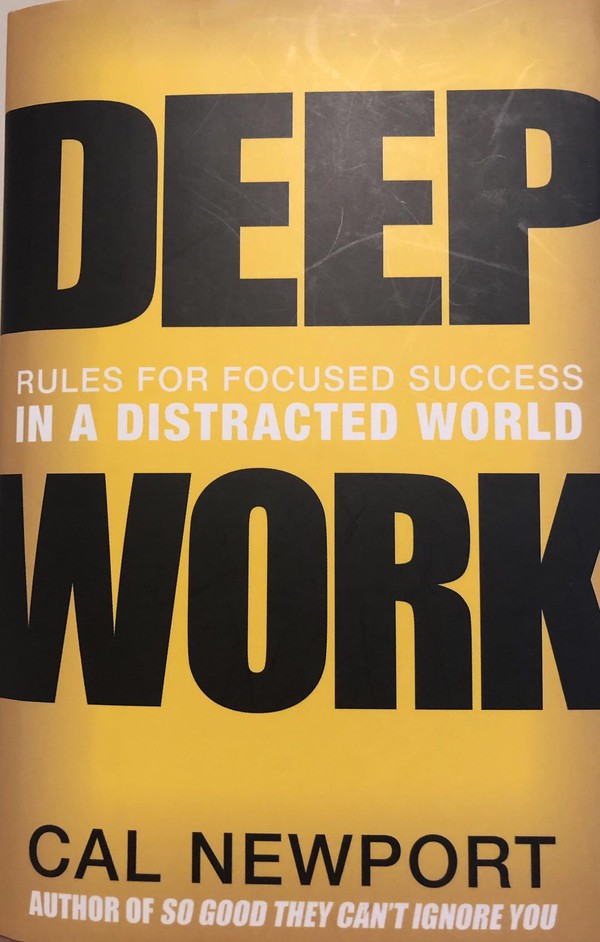读书笔记:Deep Work
anonymous-104090 06/29 10474.0/1
刘昕

Deep Work: Rules for Focused Success in a Distracted World is a recent book by Cal Newport, a professor of computer science at Georgetown University. Deep work, coined by Newport, means “professional activities performed in a state of distraction-free concentration that push your cognitive capabilities to their limit.” Deep work creates new values and improves one’s skills - the cornerstone of career success, at least in my profession. The book resonated so much with me that I felt compelled to share it.
In today’s frenetic and distracted world, two persistent obstacles to deep work are shallow work and distractions from the Internet. Shallow work, defined as repetitive routine work that is easy to reproduce, takes away time and energy for deep work. Even worse, spending too much time in a state of frenetic shallowness permanently reduces your ability to perform deep work. To combat shallowness, we should build our days around a set of carefully chosen deep work, with the absolutely necessary shallow activities batched into bursts at the periphery of the schedule. “`Absolutely necessary” to me means that my default answer to things that demand my time should be no. Furthermore, they should be handled in bursts, instead of on demand, and at the periphery, instead of during one’s highly productive time. For example, using principles from GTD (Getting Things Done), I try to limit checking emails to twice a day and batch necessary shallow tasks (e.g., taking care of unavoidable logistic issues) on Fridays.
Distraction is the daunting new challenge for our era. Like many people, I face a distracted world enabled by the almighty Internet: discussion websites, social media, and streaming content are all doing their best to grab our time and attention. So why is it bad if you just glance at Facebook when it dings? Even you really just spend five seconds on it, which is often not the case, the glance causes your mind to remain on the distraction requiring you to make a significant amount of effort to get back to the deep-work mode.
The book outlines four rules: work deeply; embrace boredom; quit social media; and drain the shallows. I will touch up on each of them next, focusing on what resonates most with me.
Rule 1: Work deeply. Working deeply is how one builds mechanisms, creates rhythm, and sets a schedule for deep work. The author suggests a few strategies: monastic, bimodal, rhythmic, and journalistic. Being a morning person, my best strategy is to make my morning hours my deep work time. I try to plan the night before what I want to study or read in the morning and do not check email until this work is done. In other words, I put the most critical and also most cognitively demanding work at my best time of the day. Finishing it early also gives me the satisfaction of making progress that is critical to my profession; and thus a piece of mind so that I can work on other tasks with more ease. A few tricks are suggested: Ritualize (to minimize resistance), make grand gestures (e.g., lock into an expensive hotel room), collaborate, execute like a business with metrics (e.g., a chain that you add to it every day), and be lazy (to recharge). Another useful trick is meditated deep work (when running or walking): have a problem formulated, variables defined, and avoid loops. Two other tips that I find useful: 1) during deep work, when need a break, go for a break, but not a distraction: i.e., it is okay to walk for a few minutes and let mind rest, but not okay to go online and get distracted. 2) as in meditation: when the mind wonders, just gently bring it back without judgement.
Rule 2: Embrace boredom. First, why is it important? In deep work, we have to acknowledge that the work is sometimes boring and we have to embrace that boredom instead of avoiding it by seeking refuge in distractions. Like muscles, the ability to focus intensely needs to be trained: its dependence on distractions weakens our mind’s ability to focus. In other words, once you are wired for distraction, your mind craves it even when you want to focus. Like many others, I take out my phone whenever I have a minute of free time. Well, do not do it. Embracing boredom is, in particular, hard for me as I have a strong tendency to multi-task, including during entertainment. To address the root cause of multitasking, I need to learn to devalue being busy and to appreciate and enjoy a quiet mind. Following the suggestions in Headspace, a quiet mind is having a mind - one can see clearly the bottom of a lake when the water is not disturbed. Meditation is probably one of the best methods in achieving this goal.
Rule 3: Quit social media. This is a tricky one. There is no argument that social media is sucking our time in an unprecedented degree. There were a few times that I engaged in heated discussions on wechat and wasted hours if not days. Furthermore, it is a huge distraction that you think you are just glancing on your Facebook page and half an hour goes by without you even noticing. I am not ready to quit social media entirely. There is a benefit to me: it can be an effective tool in information acquisition (if one knows what to check and what to avoid) and in connecting people. My current practice is to log out social media accounts, and check them ideally once a day.
Rule 4: Drain the shallows. The key point is to limit the amount of shallow work strategically. The first strategy is to “schedule every minute of your day.” While it sounds daunting or even counter-intuitive, the key idea is to build structure into the day. (We significantly underestimate our time on social media/TV and overestimate our work time :). Without structure, it is easy to devolve into the shallow - emails, social media, or web surfing. I found this useful. In practice, I put loose blocks one after another into the day, from deep work to necessary day-to-day routines. If I finish later than scheduled, I will move unfinished blocks to next day; and if I finish earlier, I pull backup work from a list. That helps much avoid devolving into email or social media. The second one is to quantify the depth of activities and the third is to ask for a shallow budget. In practice, I do not have a specific budget, but I am very careful about saying “yes.” I train myself to use “no” as a default answer. The last one is to become hard to reach and do not reply to emails by default. When replying, craft the emails carefully to avoid multiple email exchanges.


